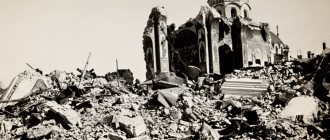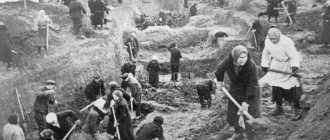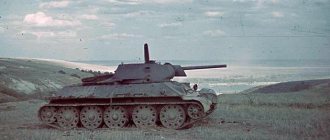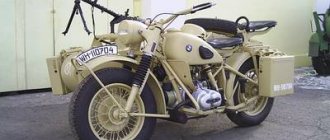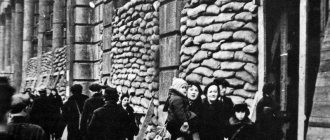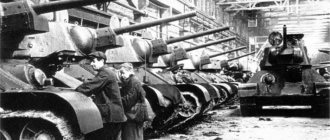Complete chronicle of the events of the Great Patriotic War for 1943
A complete list of memorable dates, battles and major historical events that occurred during the Great Patriotic War in 1943.
January 1 – February 4, 1943
- North Caucasus strategic offensive operation.
January 6, 1943
- Shoulder straps have been introduced into the army.
January 10 – February 2, 1943
- Offensive Operation "Ring".
January 12 – January 30, 1943
- Strategic offensive operation "Iskra".
January 13 – January 27, 1943
- Ostrogozh-Rossoshan offensive operation.
January 23, 1943
- The Red Army liberated Armavir.
January 24 – February 17, 1943
- Voronezh-Kastornensk offensive operation.
January 25, 1943
- Troops of the Voronezh Front liberated Voronezh.
January 29 – February 18, 1943
- Voroshilovgrad offensive operation.
January 31 – April 5, 1943
- Raid of the partisan cavalry unit of M.I. Naumov across the territory of Kursk, Sumy, Poltava, Kirovograd, Odessa, Vinnitsa, Kyiv and Zhitomir regions.
February 2 – May 25, 1943
- The raid of S.A. Kovpak’s unit through the Rivne, Zhitomir and Kyiv regions.
February 4 – April 6, 1943
- Novorossiysk landing operation.
February 7, 1943
- The Red Army liberated Azov.
February 8, 1943
- The Red Army liberated Kursk.
- The Order of Kutuzov, III degree, was established.
February 9 – March 16, 1943
- Krasnodar offensive operation.
February 15, 1943
- Shoulder straps have been introduced for Navy personnel.
February 15 – February 28, 1943
- Demyansk offensive operation.
March 2-31, 1943
- Rzhev-Vyazemsk offensive operation.
March 3, 1943
- The Red Army liberated Rzhev.
March 4-19, 1943
- Old Russian offensive operation.
March 8, 1943
- The 1st separate Czechoslovak battalion first entered into battle with German troops near Sokolovo (Kharkov region).
March 12, 1943
- The Red Army liberated Vyazma.
April 1, 1943
- The French Normandie squadron entered into battle for the first time as part of the 1st Air Army of the Western Front.
April 17 – June 7, 1943
- Air battles in Kuban.
April 29, 1943
- The formation of the 1st separate Czechoslovak infantry brigade on the territory of the USSR began.
May 6, 1943
- The formation of the 1st Polish Infantry Division named after Todeusz Kosciuszko began on the territory of the USSR.
May–June 1943
- Fights between Soviet partisans based in the Bryansk forests and a large punitive expedition of the enemy.
June 8-10, 1943
- Soviet Air Force operations to destroy enemy aircraft at airfields.
July 5 – August 23, 1943
- Battle of Kursk.
July 5-23, 1943
- Kursk strategic defensive operation.
July 12, 1943
- Oncoming tank battle in the Prokhorovka area.
July 12 – August 18, 1943
- Oryol strategic offensive operation.
July 22 – August 4, 1943
- Mginsk offensive operation.
July 25, 1943
- Mussolini's regime fell in Italy.
August 3-23, 1943
- Belgorod-Kharkov strategic offensive operation.
August 3 – September 15, 1943
- Operation Rail War.
August 5, 1943 1943
- The Red Army liberated Belgorod and Orel.
- The first artillery salute was given in Moscow.
August 7 – October 2, 1943
- Smolensk strategic offensive operation.
August 13 – September 22, 1943
- Donbass strategic offensive operation.
August 23, 1943
- The Red Army liberated Kharkov.
August 26 – October 1, 1943
- Chernigov-Pripyat offensive operation.
August 26 – December 22, 1943
- Battle of the Dnieper.
September 1 – October 3, 1943
- Bryansk operation.
September 3, 1943
- Allied troops landed in the south of the Apennine Peninsula.
September 8, 1943
- The Red Army liberated Stalino (Donetsk).
- Italy capitulated.
- German troops occupied Northern and Central Italy.
September 9 – October 9, 1943
- Novorossiysk-Taman strategic offensive operation.
September 9-16, 1943
- Novorossiysk offensive operation.
September 16, 1943
- The Red Army liberated Novorossiysk.
September 17, 1943
- The Red Army liberated Bryansk.
September 19 – October 31, 1943
- Operation Concert.
September 21, 1943
- The Red Army liberated Anapa.
- Shoulder straps for Suvorovites have been introduced.
September 21-22, 1943
- The troops of the Central and Voronezh fronts reached the Dnieper.
September 22-30, 1943
- Troops of the Central, Voronezh, Southwestern and Steppe Fronts crossed the Dnieper and captured bridgeheads on its right bank.
September 23, 1943
- The Red Army liberated Poltava.
September 25, 1943
- The Red Army liberated Smolensk.
September 26, 1943
- The Red Army liberated Khotimsk.
September 26 – November 5, 1943
- Melitopol operation.
September 29, 1943
- The Red Army liberated Kremenchug.
October 4, 1943
- The formation of the 1st Romanian Volunteer Division named after Tudor Vladimirescu began.
October 6-11, 1943
- Nevelsk operation.
October 10, 1943
- The Order of Bohdan Khmelnitsky I, II and III degrees was established.
October 10-14, 1943
- The Red Army liberated Zaporozhye.
October 12, 1943
- The 1st Polish Division named after Todeusz Kosciuszko fought its first battle near Lenino as part of the 33rd Army of the Western Front.
October 23, 1943
- The Red Army liberated Melitopol.
October 25, 1943
- The Red Army liberated Dneprodzerzhinsk and Dnepropetrovsk.
October 26, 1943
- Shoulder straps have been introduced for graduates of the Nakhimov School.
October 31, 1943
- The troops of the 4th Ukrainian Front reached Sivash and Perekop.
October 31 – December 11, 1943
- Kerch-Eltigen landing operation.
November 3-13, 1943
- Kyiv strategic offensive operation.
November 6, 1943
- The Red Army liberated Kyiv.
November 10-30, 1943
- Gomel-Rechitsa operation.
November 13 – December 22, 1943
- Kyiv defensive operation.
November 26, 1943
- The Red Army liberated Gomel.
November 28 – December 1, 1943
- Tehran Conference of Heads of Government of the USSR, USA and Great Britain.
December 6, 1943
- The Red Army liberated Alexandria.
December 13-31, 1943
- Gorodok operation.
December 14, 1943
- The Red Army liberated Cherkasy.
Source: compilation based on publicly available information on the Internet
Sovinformburo summary for December 2, 1943
Afternoon message December 2, 1943
During December 2, between the Sozh and Dnieper rivers, northwest of Gomel, our troops, continuing the offensive, occupied more than 80 settlements and among them the large settlements of Kanava, Zvonets, Stary Dovsk, Kletishche, Petravichi, Khizovo, Berestovets, Merkulovichi, Golovachi , Lozov, Negovka, Bronnitsa, Zababie, Gubichi, Dedov Kurgan, Nesoev, Nikolaev.
In the area of the lower reaches of the Pripyat River, our troops fought forward and occupied the settlements of Nizhny Mlynon, Zavoyt, Smolegov, Buda, Budki, Golovchitsy, Grushevka, Antonov.
In the Cherkassy area, our troops repulsed counterattacks by enemy infantry and tanks and inflicted heavy losses on them in manpower and equipment.
South-west of Kremenchug, our troops, overcoming enemy resistance and counterattacks, captured the strongly fortified strongholds of his defense Skobievka, Revovka, Zolataryovka, Serebryanaya, Fedorki, Dmitrovka, Protopopovka.
In other sectors of the front there was reconnaissance and artillery and mortar fire.
During December 1, our troops on all fronts knocked out and destroyed 71 German tanks. In air battles and anti-aircraft artillery fire, 23 enemy aircraft were shot down.
North-west of Gomel, our troops defeated several centers of enemy resistance and, continuing the offensive, occupied more than 80 settlements. Up to 1,500 German soldiers and officers were destroyed, 26 enemy tanks and 2 armored vehicles were knocked out and burned. Trophies were captured, including 25 large-caliber mortars and a large ammunition depot. Prisoners were taken. In another sector, Soviet artillerymen carried out a powerful fire raid on the enemy’s location and inflicted heavy damage on the Germans in manpower and equipment.
In the area of the lower reaches of the Pripyat River, units of the N-formation, repelling enemy counterattacks, moved forward and occupied several settlements. Under attacks from Soviet units, the Germans were forced to abandon their positions prepared for defense. Our fighters destroyed up to a battalion of Nazis, knocked out 5 tanks and 3 armored vehicles.
In the Cherkassy region, our troops repelled counterattacks by enemy infantry and tanks. The Germans brought large forces to this area and, regardless of heavy losses, threw them into battle. Units of the N-formation, repelling enemy counterattacks, burned and knocked out 24 German tanks. Over 1,000 enemy corpses remained on the battlefield. 8 German planes were shot down by anti-aircraft artillery fire.
South-west of Kremenchug, units of the N-formation, having broken the enemy’s resistance, captured a number of heavily fortified strongholds. In the area of the village of Bandurovka, Soviet soldiers captured large trophies from the Germans, including 27 tanks and 25 armored personnel carriers. In another sector, our troops destroyed a column of vehicles with enemy infantry. More than 400 Nazis were killed and wounded. A significant number of prisoners were taken. 7 guns, 36 machine guns, 11 anti-tank rifles, many rifles, machine guns and various military equipment were captured.
Aviation of the Black Sea Fleet sunk an enemy transport with a displacement of 2,000 tons, a tugboat and three self-propelled barges, including one loaded with vehicles and the other with tanks. In addition, two enemy vehicles and five self-propelled barges were damaged.
A partisan detachment operating in one of the districts of the Polesie region, over the course of two days, derailed 3 German military echelons heading to the front line. 2 locomotives, 7 class cars, 5 ammunition cars and several platforms with guns were destroyed. The partisans of the same detachment fired at several enemy trains with anti-tank rifles. 6 locomotives were disabled, 128 Nazis accompanying the trains were killed and wounded.
In fierce battles, the Red Army grinds down enemy manpower and equipment. According to captured soldiers, some German divisions, due to their small numbers, have been disbanded. This is also confirmed by captured documents. For example, an intercepted order from the commander of the 262nd German Infantry Division states: “Many of our soldiers fell, many were wounded, and some were captured.
Due to the fact that the general situation currently does not allow us to staff our infantry regiments, the command ordered the remnants of the 262nd division to be merged and included in the 56th infantry division. This is a heavy blow for all of us..."
A captured soldier of the 2nd ambulance company of the 293rd German infantry division said: “We were recently given an order to disband the division. The order read: “The 293rd division has become so small in number that instead of a headquarters it can easily be controlled by one person. The remaining units are united into a battle group under the command of Major Schulte. The battle group is under the command of the 866th Regiment, 355th Infantry Division."
Non-commissioned officer Heinrich B., who went over to the side of the Red Army, reported that the 333rd German Infantry Division suffered huge losses and its remnants were transferred to the 294th German Infantry Division.
The captured corporal of the 3rd battery of the 340th artillery regiment of the 340th German infantry division, Walter Mackert, said: “Our artillery regiment lost all its material. The 327th and 377th Infantry Divisions, due to terrible losses, are now combined into one division under the command of Colonel Nomm.”
The other day, the Soviet Information Bureau reported that in Sebezh and Bobruisk, the German military authorities, trying to cover up the traces of their crimes, were burning the corpses of Soviet citizens they had shot. Similar reports are coming from other Soviet areas temporarily occupied by the Germans. In Minsk, the German military authorities created several special teams to destroy graves in the vicinity of the city. Teams open numerous pits in which thousands of Soviet citizens killed by the Germans are buried, remove the corpses, douse them with gasoline and burn them. Soviet citizens, whom the Germans forced at gunpoint to excavate graves, were killed, and their corpses were also burned. The German military authorities are doing the same in the mountains. Orsha. In the second half of November, the Nazis here began opening the graves in which many peaceful Soviet citizens who died at the hands of fascist executioners were buried. The corpses were transported by car to the Orsha flax mill and thrown into the furnaces.
The Nazi authorities are trying to hide traces of the crimes they committed on Soviet soil. The Nazis are afraid of retribution for their monstrous atrocities. But no amount of tricks will save the Nazi scoundrels from severe retribution.
Battle of Stalingrad: results and significance
The results of the Battle of Stalingrad were summed up a little later, because at first it seemed difficult to see the whole picture. The approximate figures for this military operation are terrifying:
- about two million deaths from both Soviet troops and the enemy;
- the number of prisoners is more than 100 thousand people, this also includes the senior staff of Germany;
- about two thousand Wehrmacht tanks and guns were destroyed, more than 1,000 mortars, 70,000 cars and 3,000 aircraft were destroyed;
- 32 German divisions and 3 brigades were completely destroyed by Soviet troops. Another 16 divisions suffered severe logistical and human losses;
- On December 22, 1943, the Presidium of the Supreme Soviet of the USSR declared award medals “For the Defense of Stalingrad.” The lists of those awarded included 760 thousand survivors.
Sadovaya Street after the bombing: Wikipedia
It is impossible to overestimate the significance of this global battle, which radically changed the course of the Second World War:
- huge human and material losses undermined the fortitude of the German army, depriving them of their strongest foundation;
- the front line shifted and moved hundreds of kilometers away from the Volga and Don, which meant that the Barbarossa plan failed;
- The unity of the Reich's allies was destroyed, Romanian and Italian troops were defeated. The leadership of these countries thought about the advisability of further continuing the war on the side of the fascists;
- the successful outcome of the Battle of Stalingrad, as well as the further victory of Soviet troops in the Caucasus, forced Turkey to enter the war on the side of the USSR and its allies;
- The Battle of Stalingrad is a cruel lesson for the Soviet supreme leadership and marshals. The latter acquired invaluable military experience, and the victory in the Battle of Stalingrad instilled confidence in the people that the Motherland would soon be liberated from enemy troops.
The great battle of Stalingrad is a monument to selflessness, love for the Fatherland and the desire to preserve freedom above all.
Original article: https://www.nur.kz/family/school/1877018-stalingradskaa-bitva-kratko-osnovnye-sobytia/
Battle of Stalingrad: the beginning
The Battle of Stalingrad is a unique historical event, since this battle became one of the most terrible and longest, but at the same time, turning points of the Second World War. It unfolded from July 17, 1942 to February 2, 1943.
For about 200 days and nights, brave warriors not only repelled the attacks of the Wehrmacht, but also switched to offensive actions themselves. This was the beginning of a new story, the first step towards victory. The Battle of Stalingrad is still considered one of the largest scale operations, which is only confirmed by the following figures:
- The length of the front line ranged from 400 to 850 km along the banks of the deep rivers Don and Volga, and then near the walls of the city itself. This is exactly what the map of the Battle of Stalingrad looked like;
- the battles took place over an area of over 100 thousand km²;
- About 2.1 million people took part in the battle on both sides.
An example of clear tactics and strategy of the Soviet troops is what the Battle of Stalingrad is. The events can be briefly recounted as follows:
Battle for the railroad: Wikipedia
- On April 5, 1942, Hitler signed special directive No. 41, which reflected the main provisions of the Barbarossa plan. The Fuhrer considered the capture of Stalingrad strategically important. This was supposed to turn the tide of the war: the capture of the Caucasus (with huge oil deposits), as well as the developed agricultural territories of the Kuban, Don and the banks of the Volga River, gave the Nazis an advantage in forces and supplies.
- By the end of June, the enemy had established military capabilities in a small strip from Kursk to Taganrog:
- 900 thousand soldiers and high command;
- 1260 tanks;
- 17 thousand medium and small firearms and mortars;
- military airfield with 1640 combat aircraft.
The hot phase of the confrontation began on July 17, 1942. The battle for Stalingrad began with the clash of the 6th Wehrmacht Field Army, commanded by Friedrich Paulus, with units of the Soviet 63rd Army. Briefly: the first battles took place on the banks of the Chir and Don rivers.
Which regions of Russia were occupied by the Germans?
During the Great Patriotic War, the troops of the Third Reich were occupied
Belarusian, Latvian, Lithuanian, Ukrainian and Estonian SSR, parts of the Moldavian and Karelo-Finnish SSR, as well as 30 regions and territories of the RSFSR.
Interesting materials:
How should women style their hair? How do you decorate a New Year tree? How did our ancestors decorate the Christmas tree? How to decorate the Christmas tree 2022? What can replace butter in a recipe? How is B2B marketing different from B2C? Why is a pillow harmful? Why is a high pillow harmful? What does science do? What do shamans do?
